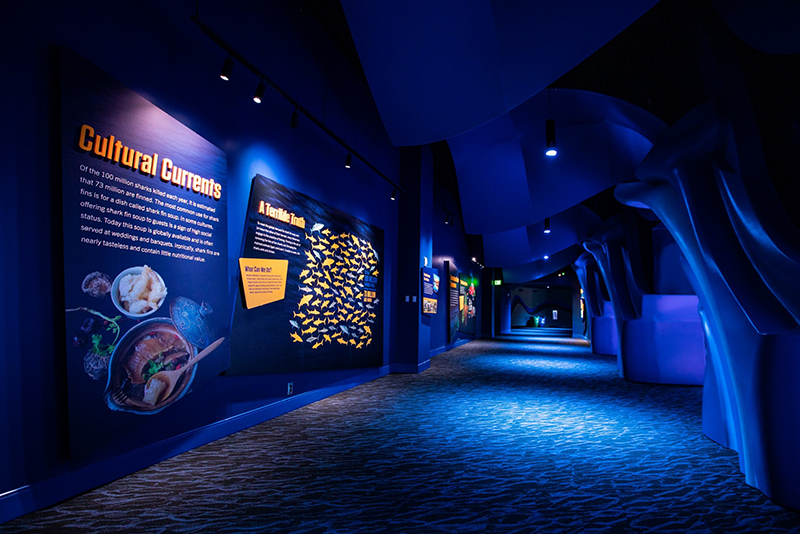Teaching Guests about Conservation and Sustainability

As committed proponents and supporters of conservation and sustainability, zoos and aquariums take a variety of approaches in actively teaching and engaging guests to participate in these efforts in their daily lives.
Georgia Aquarium, located in Atlanta, takes a broad, comprehensive approach with its messaging to get guests personally involved with conservation.
“From basic recycling and local river cleanups, to making sustainable seafood choices, and even to expert-led expeditions to the Galapagos Islands, we are demonstrating day in and day out how you can have a positive effect on marine life,” explains Joshua Blaylock, senior manager of the exhibits and projects department at the aquarium. “The overall goal is to have a little something for everyone, no matter who you are or where you’re visiting from.”
Likewise, the Monterey Bay Aquarium in Monterey, California, says that in virtually everything the aquarium does, it motivates guests to make conservation and sustainability a part of their lives. “We try to help people realize the choices they can make in their everyday lives make a tangible difference and to live an ocean-friendly lifestyle,” says Kenneth Maguire, the aquarium’s director of guest experience operations. “During interactions with guests, [staff] work with them to identify ways in which they can discover or share their own environmental identity, understand and talk about how they see themselves as a part of nature, and share ways they can be ocean champions in their personal lives.”
The Saint Louis Zoo in Missouri explicitly asks guests to make a commitment to its prominent program coined #byetobags.
“We ask them to make a pledge to support using sustainable and reusable bags rather than using plastic ones,” says Ryan Jeffery, the zoo’s director of guest experience. “We then provide a reusable bag for making the pledge. This is simply one of numerous examples of how we try to engage our guests. We try very hard to weave conservation messages into all we do.”

Best Approaches
Drawing on years of experience in testing different guest communication methods, these attractions tell Funworld what they’ve discovered to be most impactful.
“To be effective you have to know your audience,” says Blaylock. “Because of our location in downtown Atlanta, we understand our visitors are unique and diverse, from locals to international travelers and everyone in between, so the most effective [messaging] method is being as unique and diverse as possible.”
Maguire says the Monterey Bay Aquarium’s formal and informal programs include a story arc with a call to action for guests.
“Through evaluations, we’ve found that a collective impact framing and approach has been the most successful,” he says. “Personal facilitated experiences with our staff and volunteers are the most effective way to impart conservation messages, [such as] one-on-one conversations with guests while in the exhibit galleries and interacting with interpretive stations.”
He says most exhibit galleries also have supporting signage that suggest ways guests can take action. The aquarium has a Plastics Gallery exhibit featuring art created from plastic waste recovered from the ocean. Each art piece is accompanied by an exhibit label communicating the impacts on habitats and how guests can effectively help with the issue.
At the Saint Louis Zoo, Jeffery says the team discovered that personal contact with staff has the greatest impact on guests.
“Our research shows that guest awareness regarding conservation and willingness to embrace those behaviors dramatically increases when the guest interacts with an animal keeper or educational interpreter, who typically connect guests to an animal on an individual level,” he says. “Guests [with] an incredible interest in a specific animal they’re seeing often translate that relationship to their overall feelings regarding conservation.”

Channeling Guest Feedback
Jeffery says the Saint Louis Zoo receives feedback from guests about its conservation and sustainability actions.
“Our guests are incredibly passionate and proud about helping us support animals in the wild,” he says. “Our youngest guests especially are very passionate, and often vocal, in letting us know what they’re doing to help animals, and it isn’t uncommon for us to hear them telling their parents to do more.”
Blaylock says his heavy involvement with Georgia Aquarium’s “Sharks! Predators of the Deep” gallery led him to make a point of reading guest survey results and online reviews. He was curious if the conservation message was really coming across.
“It fascinates me to see how different people’s perception of the same space can be, which in a way, parallels the different perceptions of sharks,” he says. “The younger the person is, the less negative stereotypes of sharks they have. They’re growing up in the middle of a social paradigm shift, where people are starting to categorize sharks as important and essential pieces of a healthy ocean, so they’re more excited to see them and, therefore, more inclined to help them.”
He adds that the aquarium shows sharks in a way that helps guests realize they’re peaceful, beautiful, and absolutely necessary.
“I know this because almost all of the feedback I’ve consumed reflects this sort of perception change,” Blaylock says. “It’s this type of feedback that will drive the design process for every single new exhibit or guest experience we have coming up in the future.”
